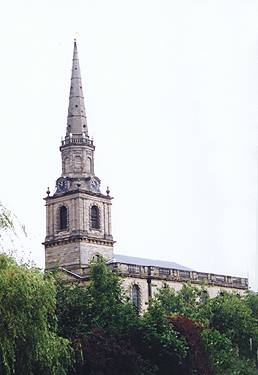|

Listing: Grade II*. Anglican church. 1758-76. By William Baker or
Roger Eykyn. Classical style. C17 organ by Renatus Harris. A very good and
complete example of a mid-C18 church.
Pevsner: 1758-76 by William Baker or the builder Roger Eykyn. ...
Organ by Renatus Harris from the Temple Church in London, c.1682.
Award: Civic Trust commendation, 1983. The Civic Trust
comments: "It is apparent, both from photographs and eye witnesses,
that the earlier state of decay of this fine Georgian church, would have
meant its near-certain demise some years ago. This act of salvation is
a remarkable example of historical restoration carried out with loving care
by all concerned. The church was designed to be of brick faced with
local Perton stone. The ravages of industrial atmospheric pollution
had disastrously eroded the external stone fabric, and in 1960 complete
re-facing was undertaken. All stonework, with the exception of the
spire, balustrade and cornice, has now been completely refaced. The
church' benefactor, the late Sir Charles Hayward, would be justly
proud of such a result". The architect for the work was A. B. Chatwin,
the contractors were Harold Fidler Ltd., and J. Oldham & Co (Stonemason)
Ltd.. Note that the benefactor concerned was the Charles Hayward
Trust.
Literature: for a detailed and up to date account of the
history of the church and a guide to the building, see the
article by Peter Hickman on this web site.
Comment: The church was built to provide for the growing
population in this part of town. It was originally set in a square, though
that square was not designed all of a piece and consisted of a variety of
Georgian buildings of different shapes and sizes. One side of the square
vanished under the ring road. The opposite side still exists but now
consists mainly of modern buildings, nearly all of them designed to be
sympathetic to the Georgian buildings - which now no longer exist.
The church's Renatus Harris organ is still in fine
fettle. The church likes to see St. John's in the Square as
closely related to St. Martin's in the Fields, and is following it
in being a fine centre for music as well as for religious purposes.

|